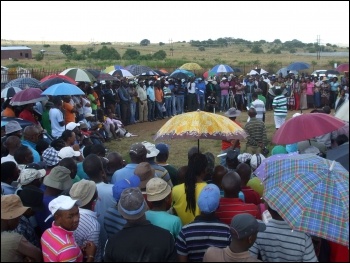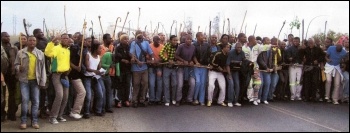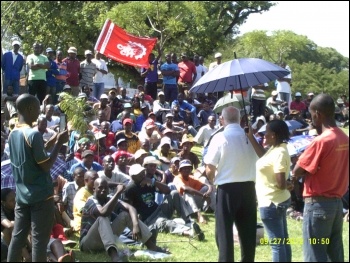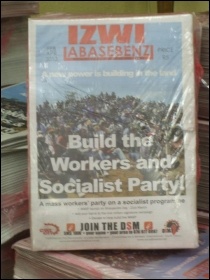South Africa: Big response for Workers’ and Socialist Party
“You cannot buy the bravery of the South African mineworkers: no surrender!”
Peter Taaffe, Socialist Party General Secretary, following a recent visit to South Africa
“I look at my 11 month old son and I am fearful for his future if I am retrenched [dismissed],” commented one mineworker at the historic conference of the Democratic Socialist Movement of South Africa (DSM, a section of the Committee for a Workers’ International). Another mineworker defiantly declared: “You cannot buy the bravery of the South African mineworkers: no surrender!”
The conference, attended by mineworkers from all the mining areas of South Africa as well as representatives of struggling communities and other workers, pledged to continue the fight against the brutal mining bosses and ruthless South African capitalists.
Standing behind the bosses and defending them to the hilt is the corrupt and increasingly discredited African National Congress (ANC) government of Jacob Zuma.
The task which this conference set itself was to assist in developing the colossal latent power of the mineworkers, in alliance with other workers, expressed through their rank-and-file strike committees, in which the DSM played a key role and which succeeded in paralysing the bosses and their government in a month-long strike last year.
It also means a struggle to replace the bankrupt and corrupt ‘unions’ – the National Union of Mineworkers (NUM), which has been found firmly on the side of the bosses in opposing the legitimate demands of the working class – with new fighting and democratic forms of union organisation.
Above all, the mineworkers and the working class generally crave their own party, free from the shackles of the ANC and its pro-capitalist policies.
Therefore, the new mass party of the working class – the Workers and Socialist Party (WASP), already launched – was enthusiastically endorsed and a timetable for collecting signatures to allow the party to register, together with many other practical tasks, were agreed unanimously.
Repressive measures
Forced to give concessions last year, the mining bosses may seek revenge through victimisations and sacking of militants, including the use of the capitalist courts and prison sentences for mineworkers.
At the conclusion of the DSM conference, I asked one mineworker from Rustenburg if he was returning to work the next day and he answered: “No – I’m going to court”. “What is the charge?” I asked, and his answer was chilling: “Attempted murder, aggravated assault, etc”. These charges were thrown out by the court and this worker was released!
Lest it be thought that this mineworker may be guilty as charged, let us recall that the ANC government and its murderous police force accused the mineworkers – and actually charged some of them – of being responsible for the infamous Marikana massacre of 34 mineworkers on 16 August! By striking and demonstrating – by exercising their legitimate rights in ‘democratic’ South Africa – they seemingly ‘provoked’ the police into callously killing a total of 43 mineworkers at Marikana alone – many shot in the back.
Following this slaughter, the South African state has sought to impose apartheid-type measures – banning orders – against the workers.
They seek to prohibit mineworkers from discussing with one another, forcing them to go straight from the mine shaft to their homes without discussion and with the sanction of fines, dismissal from the job, etc, if they disobey the dictatorial edicts of the bosses and their hirelings.
The bosses have sought to ban mass meetings and, in one mine, tried to impose 18 new conditions. This just served to harden the resolve of the mineworkers: “What have we got to lose? You cannot hit me and then tell me how I should react”, said one mineworker defiantly at the DSM conference.
The ultimate punishment meted out to the working class for carrying out the magnificent and successful strikes is the threat of widespread retrenchment.
Already in Amplats, the platinum giant, 14,000 mineworkers have been threatened with this fate. South Africa has about 80% of the world’s proven platinum reserves and platinum is a critical component of the country’s mining industry.
It is the country’s biggest export earner, its largest employer – with almost 200,000 workers involved in its production.
However, the crisis in the world economy has cut the demand for platinum and the employers are using this to attack the workers.
Gold mining is also traditionally a vital industry and still accounts for something like 150,000 employees.
Agriculture
In fact, the South African economy rests on the twin pillars of mining – and therefore of the arduous and dangerous work of the mineworkers themselves – and agriculture.
The DSM conference illuminated how the mineworkers’ struggle sparked the uprising – because that is what it was – of the agricultural workers themselves, particularly in the Western Cape.
The farmers, described by unions representing the workers as vengeful and arrogant, have benefited hugely in the post-apartheid era with a stellar tenfold growth in production and fabulous profits, while wages and conditions deteriorated.
Striking workers have been dismissed in ‘truckloads’. Previously, more than one million farmworkers were evicted from their property: “They remain slaves in the land of their birth” [The Guardian, 25 January 2013].
The bosses have traditionally used non-union labour to break strikes, but a new determination has been shown by the workers in the strike, which cost the big farmers an estimated R300 million in lost production. The unions have called for a worldwide boycott of South African wine.
Delegates from the Western Cape reported to the conference that when they visited the strike areas, they were greeted enthusiastically with the cry: “We were waiting for you!” They had seen the decisive role of the DSM in the successful mineworkers’ strikes. The trade union leadership was decidedly not as welcoming to the fighters of the DSM!
NUM stance
The reaction of other workers as well as the mineworkers gives the lie to the legend disseminated by the NUM leadership that there was a “third force” behind the strike, egging it on. “Somebody was behind the forest” [NUM president Senzeni Zokwana, The Citizen, 8 February].
There was no “third force” – unless it was the intervention of strike breakers, shamefully with support from the NUM leadership themselves.
The DSM gave expression to the legitimate anger and the revolt of the mineworkers who were ‘waiting’ for a leadership able to articulate their demands, both in the ferocious industrial battle that was underway as well as reflecting the widespread feeling amongst the mineworkers and other workers for a new mass party of the working class, revealed in WASP.
The mine bosses now wish to replace courageous class fighters with their own stooges. This has led to bitter clashes in recent days, with one mineworker killed and others injured at Amplats, where the NUM was found on the side of the bosses.
This only serves to further instil hatred for the NUM, which is utterly discredited as an organisation, as is Cosatu, purporting to represent the mineworkers.
The mineworkers have exploded in rage against their conditions as well as their own organisation’s complicity in this.
Mass struggles
The current strike wave and social upheavals are the biggest since the collapse of the apartheid regime, with South Africa now registering the highest number and the most violent strikes in the world.
Force and repression by the state – more visible in South Africa on the streets through the “armed bodies of men and their material appendages” of repression, as expressed by Friedrich Engels – will not alone hold the masses in check.
Eruptions – revolution to give it its right name – will inevitably follow the present upheavals. Moeletsi Mbeki, brother of former president Thabo Mbeki, and now a political economist, has predicted that South Africa will face a “Tunisia day” by the year 2020! His diagnosis is accurate; the date when a mass uprising will take place may be sooner than he thinks.
All the ingredients are already present for South Africa to emulate the Middle East and North African revolutions.
South African capitalism has historically risen to become the strongest economy in the whole of the African continent.
Its very development has created a powerful industrial working class. And yet the fruits of this labour have never been passed to the working class.
The day-to-day reality of South Africa is virtually a state of constant upheaval. The mineworkers’ strike is just the latest but most important and starkest expression of this process.
Many other sections of the working class, not just the mineworkers – like car workers, nurses, teachers, have taken or threatened strike action.
Also, a virtual permanent state of semi-insurrection in the townships is indicated, ironically, by registered police reports.
These show that an estimated 3 million people took part in protests against the lack of services that elicited a police response in 2008-09.
This involved 5% of the total population forced to physically confront the police in order to achieve basic services.
About 100 policemen die every year, usually as a result of crime but this ultimately has social roots; 57 were killed in 2012, up to the Marikana massacre.
These figures do not take account of workers and civilians killed by the police themselves, symbolised by the Marikana killings.
Inequality and social conditions
And the anger since then has not abated but has grown. Indeed, the endemic violence which characterises South Africa is symbolised by the recent death of the girlfriend of the well-known Paralympic competitor, Oscar Pistorius.
Privileged whites, as well as, increasingly, the richest black elite, protect themselves from the anger which this engenders behind gated communities, which are armed to the teeth.
Virtually every house in a white neighbourhood, we observed, warns of “armed response” in the event of break-ins.
This is an indirect expression of the catastrophic social situation: “South Africa is the most unequal society on the planet.”
Youth unemployment at over 50% is on the scale of Greece or Spain. The average worker supports, on the minimum wage, up to eight people. 50% of all workers earn less than R3,000 a month ($350): “Many of these workers are the sole income earners in their household” [Jay Naidoo, Financial Times, 27 August 2012].
Fifteen million South Africans are only saved from starvation by the social grants they receive every month. The mineworkers do not inhabit leafy suburbs – where the black elite comfortably rubs shoulders with the white elite – but reside in townships in squatter camps, without basic resources, sometimes even without electricity, living in miserable shacks which pass for homes.
On the other hand, the lords of the ANC inhabit a world far from that of the masses. President Zuma himself lives in a palace – a compound – which had an upgrade recently at the cost of £18 million, with rich South African businessmen reported to be secretly financing his lavish lifestyle.
So removed is he from the mineworkers and the poor masses that when he visited the scene of the massacre in Marikana, he did not even visit the mines or the shacks of the mineworkers themselves.
Unbelievably, he sought to excuse the massacre, on the grounds that, “How many other people would have died if, for example, police did not move to disarm these people?”.
These “people”, striking mineworkers, had been shot down like dogs by Zuma’s police. Zuma’s answer was the setting up of a judicial review: “You would not have had that during apartheid days.
“That’s the beauty of democracy, because it doesn’t mean that when you have got democracy, there will be no such mishap” [Guardian, 14 December 2012].
“A “massacre” is just a “mishap”. You cannot eat “democracy”; democratic rights – above all, the right to strike and vote – are for the working class weapons to fight for a better life.
But under failing South African capitalism, when they exercise their rights, they are met with repression.
ANC rule
Marxism has long predicted such a development. We wrote in 1994 at the very beginning of ANC rule: “How long will it be before an ANC government sends in police and army units against striking workers or rebellious inhabitants of the African townships?…
“The ANC as a majority, will be subject to remorseless, contrary and counter-class pressures” [‘South Africa: From slavery to the smashing of apartheid’, 1994].
Sometimes it takes decades for Marxist perspectives to be borne out but borne out they have been!
The gulf between the insurgent masses of South Africa and their rulers is of Grand Canyon proportions.
It is impossible to reconcile the class forces that oppose each other in this explosive situation. The ANC, the capitalist establishment that it now represents, which also includes the so-called ‘Communist’ party (SACP), and the corrupt trade union leadership have all been rejected by the South African masses.
A new mass workers’ party – WASP – is not just an idea, but is becoming a reality in South Africa today.
The capitalists have long recognised that the ANC is discredited. Fearing that the ground is shifting decisively beneath their feet towards the left and that the political vacuum could be filled by a party like WASP, the Economist magazine recently urged the formation of a ‘liberal’ new party.
This they believe could head off the development of a new fighting socialist party of the masses.
In answer to this call, a former anti-apartheid activist and ‘soulmate’ of Steve Biko, murdered by the apartheid regime, Dr Mamphela Ramphele, has launched a ‘platform’ around which such a party she and the capitalists hope could emerge.
She is a former managing director of the World Bank and was, until recently, chairman of the mining company Goldfields.
This party – ‘Agang’ (‘Build South Africa’ in the Sotho language) – has no clearly defined policies.
The Financial Times clearly sees this new party’s prime role as forcing the ANC into a coalition with this party and others after the 2014 elections: “The prize would be to force the ANC below the 50% threshold it needs to govern alone.”
The working class needs a clear, independent political class alternative, not another pro-capitalist one.
While it is not excluded that ‘Agang’ can become a temporary political home for refugees from the ANC, it will not find a big echo amongst the masses.
The social situation and the newly-arisen workers’ movement do not provide fertile soil upon which such a party can grow and develop.
Nor will the ANC be able to burnish its image as a vehicle for the masses by the demise or removal of Zuma and his replacement by somebody like Cyril Ramaphosa – who bid £1.4 million to buy a prize buffalo – to save it.
Its days are numbered. Despite the claims of Zuma that it will last for another hundred years, splits and divisions will occur in the ANC as well as in Cosatu.
The best and most fighting elements of the South African working class will find the road towards WASP.
The idea of a new mass workers’ party has existed in South Africa almost from the first days of the ANC government.
For instance, the metalworkers’ union NUMSA came out in favour of a mass workers’ party in 1993, before the ANC came to power! It still remains pledged to this idea whose time has now come.
The future belongs not to the discredited ANC and its allies, who are propping up the old order, but for a party which represents real socialist liberation, WASP.
This version of this article was first posted on the Socialist Party website on 21 February 2013 and may vary slightly from the version subsequently printed in The Socialist.













